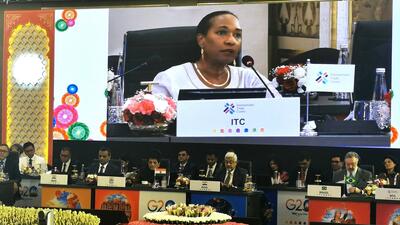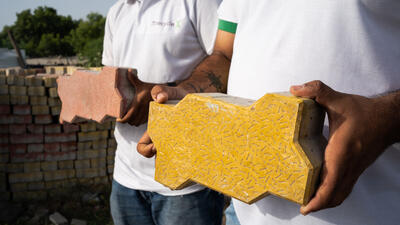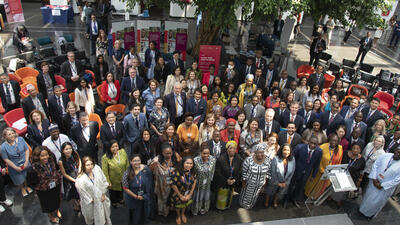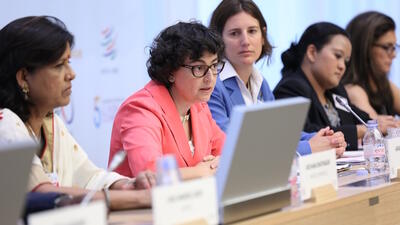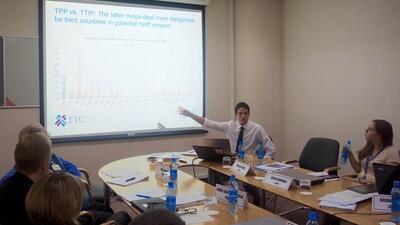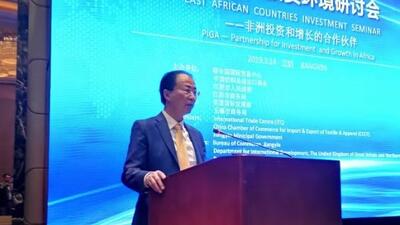

Bridging the gap in Ethiopia’s Textile value chain using existing skills and traditions: SITA’s five ingredients for creating a self-sufficient Handloom unit
- SITA identified the potential of Ethiopia’s existing skills and long tradition of handloom weaving to fill the gap in the domestic textile value chain.
- The knock-on effects are profound: the weavers are getting better livelihoods, and the subsector will create new meaningful employment opportunities to women and youth in rural areas.
- On top of SITA’s asset-based approach, the SITA team recognise five ingredients that have been key to bringing these impressive outcomes to fruition: leveraging the untapped resource of India’s experience; transferring Indian technology to Ethiopia in key areas, and supporting its use; a winning model that was tried and tested in India; upskilling of weavers; and the company’s Covid-19 pivot
The Ethiopian textile and garment industry is growing rapidly and could be a powerful means for inclusive growth and Sustainable Development. However, despite impressive growth to date, the domestic value chain remains fragmented. For example, yarn is readily available, but finished fabric suitable for manufacturing clothes is not. As a result, Ethiopia exports lower value textile goods for lower revenues, whilst importing 90% of the fabric that clothes Ethiopia’s growing population.
In search of solutions, SITA took an asset-based approach (i.e. focusing on what the Ethiopian textile sector has, rather than what it lacks). SITA identified the potential of Ethiopia’s existing skills and long tradition of handloom weaving to fill this gap. By supporting weavers to integrate key parts of the cotton-to-fabric process, SITA is working to transform the subsector and, in so doing, generate a domestic supply of sustainable, quality fabric for designers and manufacturers further up in the value chain. Crucially, SITA has set up a producer-owned company, comprising 10 weavers and two helpers, which weaves fabric by sourcing locally available yarn.
Every year, the Ethiopian Institute of Textile and Fashion Technology (EiTEX) hosts an International Conference on Cotton, Textile and Apparel Value Chain in Africa. In recent news, SITA’s cooperative, Tana Shema, participated in this year’s exhibition and bazaar. There was also a fashion show, in which Tana Shema presented their collection; to boot, a group of fourth year fashion design students also presented a second collection that had been crafted from Tana Shema fabric. The company was exposed to 1000 other delegates; weavers made sales, received orders, and generally connected with different national and international entities. This was a big ‘hurrah’ moment for Tana Shema, whose progress has been many years in the making.
Historically, the Tana Shema producer company was fully dependent on ITC, but as of the last six months, this unit is self-sufficient, selling fabric with an average sale of about USD 2500 per month. The company runs itself and covers all its own costs, including paying a service fee to Enat Shema, an operations management company established and supported by SITA. The knock-on effects for the weavers are profound: the (often women) weavers are getting better livelihoods, and the subsector will create new meaningful employment opportunities to women and youth in rural areas.
And how has SITA achieved all this? On top of SITA’s asset-based approach, the SITA team recognise five ingredients that have been key to bringing these impressive outcomes to fruition:
1. Leveraging the untapped resource of India’s experience
Today, India is a world leader in handloom fabric production, with an estimated 4.3 million people directly involved in the 335-million-dollar industry. However, rewind 20-30 years and Indian weaving communities were facing challenges similar to those faced in Ethiopia today. As such, India has a vast pool of expertise that is extremely well-suited to the Ethiopian subsector. One example is in technology. In India, improvements in loom technologies (e.g., semi-automated solar powered looms) have increased weaver productivity and enabled diversification of designs. Another example is India’s work to find alignment between what consumers want and want weavers want: this knowledge about how to develop products that meet growing international markets, whilst also preserving the traditional weaving heritage in the country, will be key for Ethiopia’s success too.
By leveraging all the potential of Indian-Ethiopian knowledge sharing, SITA’s work on handloom has been well-informed. Good decision-making has streamlined the initiative and lessons have not had to be learnt ‘the hard way’ or ‘the long way’.
2. Transferring Indian technology to Ethiopia in key areas, and supporting its use
Dyed yarn is in higher demand than undyed yarn. However, traditional dyeing techniques using plastic barrels in open conditions are not safe – neither for the weaver nor for the environment. SITA supported Tana Shema to install a yarn dyeing unit, the liquid discharge from which is treated in an Effluent Treatment Plant. Meeting environmental and personal safety standards will mean the dyed yarn can be marketed nationally and internationally as sustainable as well as handmade. Further down the line, dyed yarn can be used by our own weavers to produce fabric as well as sold to the larger weaving community.
Tana Shema weavers have also been kitted-up with six modern, Indian looms for Tana Shema weavers, which produces a finer quality of fabric. SITA imported two of the looms directly from India, the other four were replicated locally.
Together, these technologies have helped Tana Shema to get profitable and become attractive to potential financiers, fast.
3. A winning model: establishing a producer-owned company propped up by an organizational management company
Ethiopia has a strong weaving tradition and a climate conducive for expansion of cotton and eri-silk production – with ongoing initiatives at farm level. However, further up the value chain, there’s been less support. To optimize its support, SITA turned to innovative new business models that have sprung up in the Indian weaving sector and proven successful. SITA selected one such model, geared towards sustainability and high social impact: a producer-owned social enterprise, propped up by organizational management support to ensure self-sufficiency. By customizing this Indian-tested model to Ethiopian’s conditions, practices and systems, SITA has enabled impoverished weavers to own their company, directly share their profits and take pride in their livelihoods.
Setting up a producer-led company has been achieved in partnership with EiTEX (which is one of the best Textile Universities in the country), the Bahir Dar Regional Enterprise Bureau, and civil society organizations such as WISE.
4. Building skills
A large portion of the growth of Ethiopia’s textile industry to date is thanks to inflows of Foreign Direct Investment (FDI), driven by Ethiopia’s preferential market access benefits to the EU and USA. To sustain these flows, Ethiopia needs to have a skilled workforce that produces quality. As well as having upskilling at its core, SITA has trained 10 weavers and two laborers on weaving techniques and garmenting. The result? More efficient production and a shift towards self-sufficiency of the unit.
One weaver, Sefialem, explained what SITA’s training meant for her: “before I became a weaver, I was a laborer. I was not healthy enough to continue working, so I did not have enough to support myself. SITA’s training made me confident enough to call myself a weaver, and the satisfaction of seeing my products made my life a whole lot happier. My skills now give me higher income, which is more than enough to support myself.”
5. COVID-19 Pivot
During the peak of the pandemic, SITA trainers helped the weavers pivot towards production of masks. Tana Shema leveraged its strengths as a producer of fabric in order to turn the pandemic from a threat into an opportunity. This asset-based approach has been key to the success of SITA’s handloom programme from the beginning; in the case of the Covid-19 pivot, it paved the way for impressive milestones: between March and July 2020, the SITA-supported handloom unit manufactured 85,500 masks, 8,150 PPE suits and 2,100 Sanitary pads for EiTEX.
SITA’s handloom initiative is successfully positioning handloom as a solution to the gap in Ethiopia’s textile manufacturing supply chain. But the positive outcomes do not stop there. Youth unemployment is a huge challenge for African countries, particularly in rural areas. As a rural industry, a thriving handloom sector is also a stable source of much-needed rural employment. In particular, a flourishing handloom sector can create jobs for women, which will enable them to make their contributions to help businesses and markets grow. What’s more, once economically empowered, women tend to invest extra income in their children, providing the surest route to true sustainable development.
The success of Tana Shema is all thanks to these five ingredients. In sharing this not-so-secret recipe, SITA encourages other development actors to follow the same principles.





